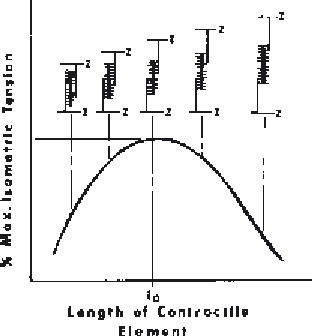Biomedical Engineering Reference
In-Depth Information
Figure 9.7
Tension produced by a muscle as it changes length about its resting length,
l
0
. A drop in tension on either side of maximum can be explained by the interactions
of cross-bridge attachments in the contractile elements.
At resting length, about 2
.
5
μ
m, there are a maximum number of cross-bridges
between the filaments and, therefore, a maximum tension is possible. As the
muscle lengthens, the filaments are pulled apart, the number of cross-bridges
reduces, and tension decreases. At full length, about 4
.
0
μ
m, there are no
cross-bridges and the tension reduces to zero. As the muscle shortens to
less than resting length, there is an overlapping of the cross-bridges and
interference takes place. This results in a reduction of tension that continues
until a full overlap occurs, at about 1
.
5
μ
m. The tension doesn't drop to zero
but is drastically reduced by these interfering elements.
9.1.2 Influence of Parallel Connective Tissue
The connective tissue that surrounds the contractile element influences the
force-length curve. It is called the
parallel elastic component
, and it acts
much like an elastic band. When the muscle is at resting length or less, the
parallel elastic component is in a slack state with no tension. As the muscle
lengthens, the parallel element is no longer loose, so tension begins to build
up, slowly at first and then more rapidly. Unlike most springs, which have
a linear force-length relationship, the parallel element is quite nonlinear. In
Figure 9.8, we see the force-length curve of this element,
F
p
, combined with
that of the overall contractile component
F
c
. If we sum the forces from
both elements, we see the overall muscle force-length characteristic,
F
t
.The
force-length curve typically presented is usually for a maximum contraction.
The passive force,
F
p
, of the parallel element is always present, but the
amount of active tension in the contractile element at any given length is










Search WWH ::

Custom Search